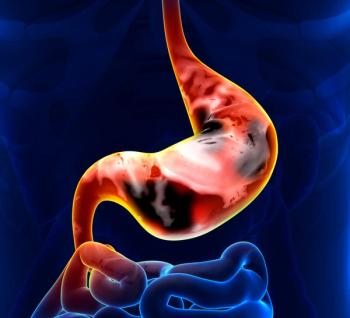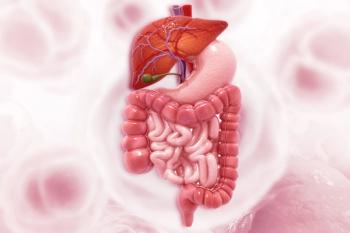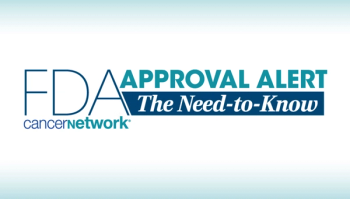
Oncology NEWS International
- Oncology NEWS International Vol 11 No 7
- Volume 11
- Issue 7
Celecoxib Added to IFL Reduces Toxicity in Patients With Metastatic Colorectal Cancer
PORTLAND, Oregon-In a phase II trial of patients with unresectable or metastatic colorectal cancer, celecoxib (Celebrex) given with irinotecan (CPT-11, Camptosar), fluorouracil (5-FU), and leucovorin (IFL) appears to reduce toxicity, Charles D. Blanke, MD, associate professor of medicine, Oregon Health & Science University, said at the 38th Annual Meeting of the American Society of Clinical Oncology (abstract 505).
PORTLAND, OregonIn a phase II trial of patients with unresectable or metastatic colorectal cancer, celecoxib (Celebrex) given with irinotecan (CPT-11, Camptosar), fluorouracil (5-FU), and leucovorin (IFL) appears to reduce toxicity, Charles D. Blanke, MD, associate professor of medicine, Oregon Health & Science University, said at the 38th Annual Meeting of the American Society of Clinical Oncology (abstract 505).
"Preliminary data suggest that celecoxib may be important in the IFL profile," Dr. Blanke said.
IFL is the standard of care for these patients, but the weekly schedule is associated with severe neutropenia and grade 3-4 diarrhea. The objective response rate with the weekly schedule is 39%, median progression-free survival 7 months, and median overall survival 14.8 months.
Cyclooxygenase-II (COX-2) is expressed in most colorectal cancers, and expression is correlated with larger tumor size, deeper invasion, and higher rates of lymph node involvement and distant metastasis. "In potentially curatively resected patients, a high level of COX-2 expression in the primary tumor correlates with a statistically shorter disease-free survival," Dr. Blanke said.
There are a number of mechanisms by which COX-2 expression is linked to the initiation or promotion of invasive cancer, he said, including angiogenesis; increased tumor cell proliferation, motility, and general invasive-
ness; and induction or resistance to apoptosis.
Celecoxib is FDA approved for treatment of arthritis and familial adenomatous polyposis (FAP). For FAP, the approved dose is 400 mg twice daily. In preclinical studies, celecoxib has been combined with chemotherapeutic agents, such as 5-FU and irinotecan. Rodent studies suggest that celecoxib may be associated with decreased diarrhea when given with irinotecan.
Phase II Trial
Based on that information, five institutions began enrolling patients with advanced colorectal cancer into a phase II trial in which the patients would receive celecoxib plus IFL. The trial started with a 2-week course of celecoxib, 400 mg twice daily given alone to separate potential toxic effects of the COX-2 inhibitor.
Patients tolerating celecoxib then receive the standard course of the IFL regimen, weekly times four every 7 weeks. Patients were treated until progression or intolerable toxicity occurred. Patients received a median of two cycles (range, one to nine).
"The primary goal of the study is to determine the objective response rate for advanced colorectal cancer patients treated with a combination of celecoxib and weekly IFL," Dr. Blanke said. "Other efficacy parameters include event-free and overall survival. In addition, we aim to assess the safety of combining celecoxib with standard chemotherapy. We hope this trial might serve as a pilot for randomized studies."
Patients were required to have histologic or cytologic confirmation of measurable large bowel adenocarcinoma not curable with surgery or radiation therapy, and adequate liver, kidney, and bone marrow reserve. ECOG performance status started at 0 to 2 but was amended to include only patients with 1 or better.
Patients treated for incurable metastatic disease were excluded. Those having received adjuvant chemotherapy were excluded if they had relapsed within 12 months or received any chemotherapeutic agents except 5-FU, plus or minus standard modulators.
Irradiation to a significant portion of bone marrow or standard rectal cancer irradiation prevented enrollment as did active ulcer disease, sulfa allergy, lactose intolerance, use of full-dose nonsteroidal anti-inflammatory drugs (NSAIDs), lung disease, or pleural or abdominal fluid collection requiring drainage. Patients at risk for cardiac or thrombotic events were allowed to take low-dose aspirin.
Twenty-two of the 25 originally enrolled patients were evaluable for toxicity and 21 for efficacy. Mean age is 61 years. Only two patients had received previous adjuvant therapy.
Study Results
The partial response rate was 24% in this intent-to-treat analysis; 43% had stable disease for at least 7 weeks; 14% had frank progression. Nineteen percent were taken off study without reassessment, half due to adverse events and the other half due to withdrawal of consent. The median duration of response was 6 months.
Dr. Blanke noted that the planned study accrual is 54 patients. "Thus, the confidence intervals for response on the small number currently accrued are very large," he said.
Eighteen percent of patients had abnormal electrolytes, and an additional 14% had hyperglycemia, possibly due to dexamethasone administration. Neutropenia occurred in 27% of patients, but infection was rare. Severe diarrhea or nausea developed in 23% of patients. Ileus occurred in two patients, intestinal perforation in one, and pancreatitis in one.
Three patients experienced thrombotic events: Two had cerebrovascular accidents (one of whom died,
representing the only potentially therapy-related death), and one had a myocardial infarction.
"Adding celecoxib to IFL is associated with a response rate of 24%, median progression-free survival of 6.8 months, and median overall survival of 10.7 months," he said. "It is possible that the large portion of patients who stopped therapy only due to fear of cardiotoxicity may have confounded the results. It appears that patients treated with celecoxib/bolus IFL may have less toxicity than those historically treated with IFL alone."
Articles in this issue
over 23 years ago
Good Activity for Capecitabine Confirmed in European Studyover 23 years ago
Capecitabine/Vinorelbine Effective in Heavily Pretreated PatientsNewsletter
Stay up to date on recent advances in the multidisciplinary approach to cancer.
















































































